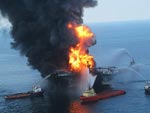 The Coast Guard released a report yesterday that was highly critical of Transocean, the owner of the Deepwater Horizon drill rig, which exploded and sank last year.
The Coast Guard released a report yesterday that was highly critical of Transocean, the owner of the Deepwater Horizon drill rig, which exploded and sank last year.
Transocean contributed to Gulf disaster, Coast Guard report says
Flaws in Transocean Ltd.’s emergency training and equipment and a poor safety culture contributed to the deadly Deepwater Horizon drilling rig explosion that led to the Gulf oil spill, according to a Coast Guard report released Friday.
Electrical equipment that may have ignited the explosion was poorly maintained, while gas alarms and automatic shutdown systems were bypassed so that they did not alert the crew, the report said. And rig workers didn’t receive adequate training on how and when to disconnect the rig from the well to avoid an explosion, it said.
“These deficiencies indicate that Transocean’s failure to have an effective safety management system and instill a culture that emphasizes and ensures safety contributed to this disaster,” the report said.
As perhaps is not surprising, Transocean takes serious exceptions to the report.
We recently reviewed Fire on the Horizon: The Untold Story of the Gulf Oil Disaster by John Konrad and Tom Shroder. (A fascinating book. ) The book describes a management that was seriously committed to safety. It just may have been focusing on the wrong things, looking at the trees rather than the forest. Fire on the Horizon describes the numerous safety initiatives by Transocean, designed to prevent worker injuries. When the rig exploded, it had not had a lost time accident for seven years. Ironically, four BP and Transocean executives were on board the platform for a safety review and to congratulate staff on the safety record when the blow-out took place.
To prevent accidents from dropped tools, for example, Konrad writes, “Transocean attacked the problem in typical fashion — with an acronym, a set of principles, and an aggressive program of proselytizing to drive these principles home. This included signs, literature, tons of required documentation and forms to fill out, and, of course, meetings.”
Nevertheless, while paying close attention to the small things, it appears that larger problems may have gone unattended. The blow-out-protector, which failed catastrophically, was five years overdue for its five year inspection. The rig’s mainframe computer, which controlled the fire and gas detection and alarm systems, among other things, was outdated and unreliable. Several safety systems were bypassed. The rig itself had been in service for nine years and had never been dry docked.
Konrad continues: “Both Transocean and BP put a lot of money, time and effort into promoting the “core value” that any worker at any time could stop work he deemed unsafe. But half of the worker surveyed said they feared if they spoke up, especially things controlled by managers in Houston, they’s face serious problems.”
Ultimately, we are left with the contradiction that the Deepwater Horizon had an impeccable safety record while also blowing up, killing eleven workers, and causing the largest accidental offshore spill in history. No doubt we will earn more as the investigation continues.
Thanks to Phil Leon for passing the article along.
